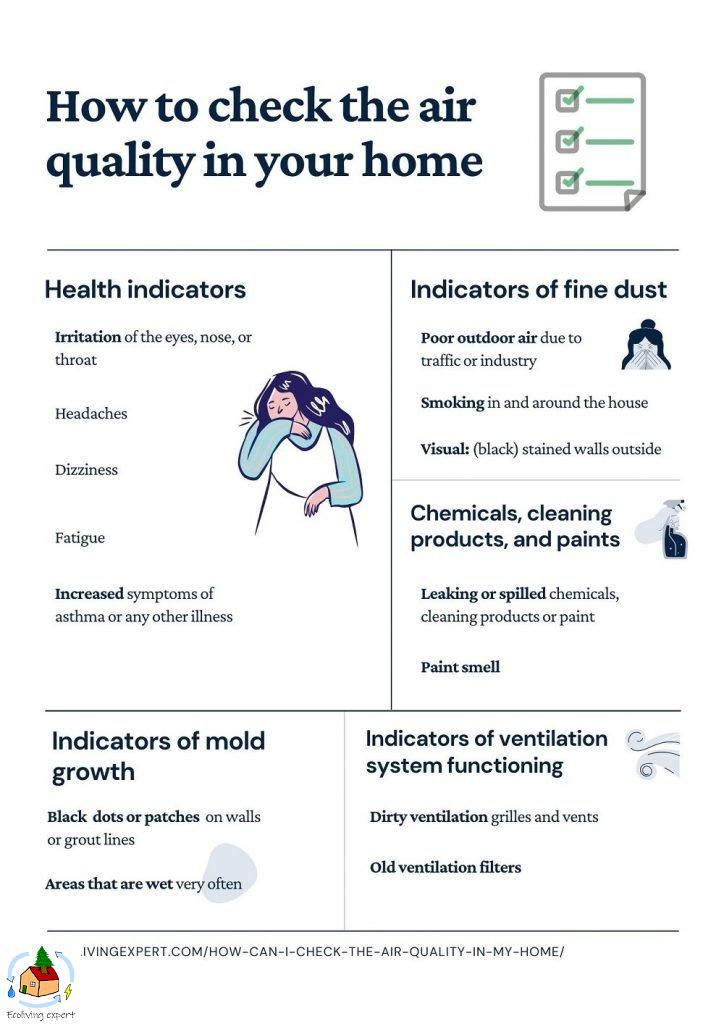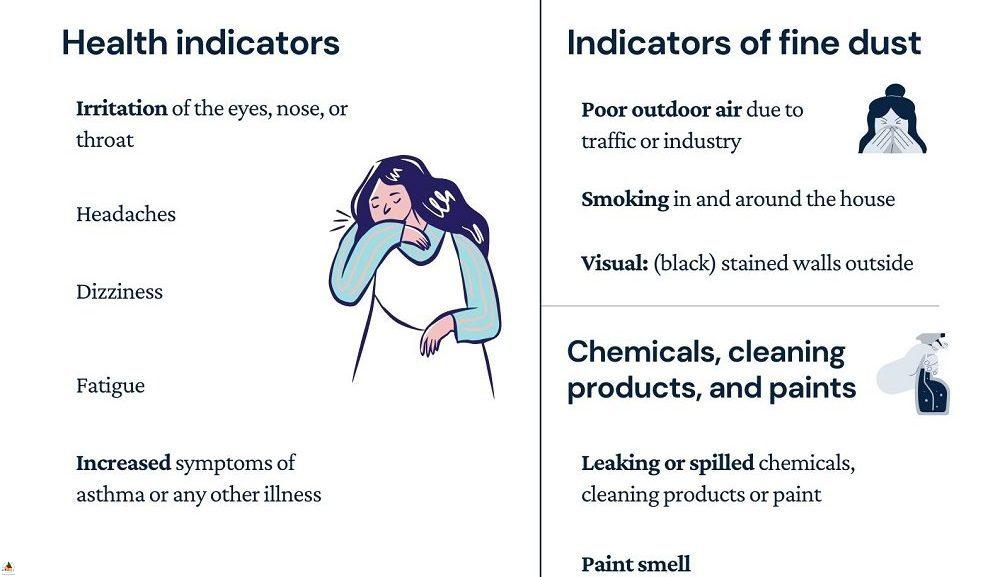Your indoor air can be full of potentially harmful compounds. But without an air quality monitor, how do you know if your air is safe and clean?
If you want to check your indoor air quality yourself, you should focus on indicators of poor air. If any or several of these indicators are true for your house, you might have poor air quality.
To check the air quality of your house, look for these indicators:
- health symptoms (irritation of eyes, nose, throat, headache, dizziness, and fatigue)
- indoor dust
- indoor mold growth
- chemicals, cleaning products, and paint
- the condition of your ventilation system
There is no way of knowing if these indicators result in poor indoor air quality without actually measuring the indoor air. However, they can help you target potential sources of air pollution. After removal of the source or other changes regarding these indicators, you will hopefully have eliminated the source of poor indoor air quality.
Health symptoms that indicate poor air quality
Poor air quality can result in all kinds of health problems, ranging from minor complaints to serious long-term effects. Normally health effects due to bad air quality will be minor such as dry eyes, a little fatigue, or a cough. However, some compounds can have more serious health effects.
The first symptoms to be aware of
The most common symptoms of air pollution are due to short-term exposure to low amounts of pollutants. These symptoms include:
- irritation of the eyes, nose, or throat
- headaches
- dizziness
- fatigue
- increased symptoms of asthma or any other illness
Important factors in experiencing health effects are your overall wellbeing, age, and possible sensitivity to the compound. Additionally, increased exposure due to higher concentrations, and longer exposure time increase the potential health effects.
Common health effects from long-term exposure
According to the Environmental Protection Agency (EPA) of the United States. long-term health effects of indoor air pollutants may show up years after exposure or after long or repeated periods of exposure. Possible long-term adverse health effects include:
- respiratory disease
- heart disease
- cancer
These effects may show up years after exposure to hazardous compounds and can be the result of many and any combination of factors. Therefore, it is almost impossible to contribute these health effects to poor indoor air quality.
Children show symptoms earlier
Children are more susceptible to indoor air pollutants because they inhale more air and thus pollutants per kg of bodyweight than adults. Additionally, children’s airways are narrower than adults, so irritation and swelling of the airways can result in relatively greater airway blockage.
Therefore, look at (your) children and how they are feeling when they are in the bedroom for a long time. If they seem to show health effects that might indicate poor indoor air quality, it might be time to take measures.
Indoor dust particles
Relatively high amounts of indoor dust can be an indication of poor air quality. But since the smallest dust particles are also the most dangerous, it is possible that even without much visible dust your indoor air is still harmful to your lungs.
These tiny dust particles are also called particulate matter or fine dust. These particles can be formed in many ways including fires, car exhausts, or a combination of chemicals that are emitted by industries and powerplants. (source)
If you live in the United States, you can check your local outdoor fine dust and other air pollution data on https://www.airnow.gov/.
Indicators of fine dust particles in your home are health symptoms related to the airways such as:
- irritation of the lungs and throat
- coughing or difficulty breathing
- increased symptoms of asthma and other respiratory ailments
Other indicators that can point to indoor fine dust are smoking (including neighbors that smoke), heavy outdoor traffic, and regular outdoor dust and low outdoor visibility. An excellent visual indicator is stained or damaged stones and other building materials. If you see that your outdoor walls have black stains or get dirty quickly, this can be an indicator or poor outdoor air, and therefore relatively poor indoor air.
The picture below shows clearly what black stains look like from soot and other air pollutants.

Carpets, rugs, and dust for indoor air quality
The relation between carpets and rugs and indoor air quality is an interesting one. Carpets and rugs trap dust particles that are kicked back into the air when you walk over them. Hereby, they contribute to a continuous circulation of airborne dust.
However, since carpets and rugs trap dust particles, they can be a dust sink when vacuumed regularly. Hereby, they can potentially contribute to the removal of airborne dust.
Additionally, carpets and rugs can themselves be a source of dust and hazardous compounds since they wear out every time you walk on them.
If you are considering purchasing a rug, or already have a carpet or rug and want to replace it, I recommend to consider buying a natural rug that does not contain hazardous substances.
Natural rugs
I found a company called Natural Area Rugs that sells rugs made from all-natural materials such as jute, sisal, and even seagrass. These rugs really look amazing and do not emit any VOCs. You can find these wonderful rugs on naturalarearugs.com.
Indoor mold growth
The spores of molds are always present in the air in very small quantities. They normally do not pose any health hazards. However, when mold spores land in a spot that is humid and warm, they can start to grow and produce very high quantities of spores. This can lead to various health effects and can damage wood and fixtures.
You can check for molds by looking at places that often become wet, and/or places where food scraps can linger. The kitchen and bathroom are common areas of mold growth, areas to check are:
- bathroom mat
- bathroom tile grout lines
- shower curtain decoloring
- around the toilet
- walls near boilers and other water heaters
- window frames
- houseplants (the pots, soil, and nearby walls)
Mold is quite easily recognized by dark (often black or dark green) dots or stains and patches.
Chemicals, cleaning products, and paints
Surprisingly even cleaning products are a source of indoor air pollution. They are often made of various chemicals that are released into the air when they are used or during storage.
Check if your chemicals and cleaning products are of natural origin. Otherwise, they could be emitting a variety of potentially hazardous compounds into your indoor air. It is best to use natural products and to make sure they are not leaking or have spilled in your storage area.
Paint can be another source of indoor air pollution. They can release gases that can be harmful to your health, especially when you have just painted. You can often tell by the smell that comes from your paint that it is emitting potentially harmful compounds. Therefore, make sure you are airing during painting, and keep your ventilation system on and in good condition.
According to an extensive study on the release of Volatile Organic Compounds (VOCs) during and after painting, it is recommended to at least not use the painted room for 14 days. Another option is to use low-VOC paint.
Ventilation system functioning
The most important method of preventing poor indoor air quality is your ventilation system. It should be running all the time and has to be in good condition to function properly.
Therefore, a good indication of your indoor air quality is the condition of your ventilation system. You should regularly check, clean, and replace your ventilation filters, vents and grilles to keep them in good condition. You can quickly identify if they need cleaning by how dirty they are.
Additionally, make sure to replace your ventilation filters approximately twice a year. This will depend on how quickly they get dirty, whether you have pets, and if you have preexisting respiratory issues.
What about test kits?
I looked around at the available test kits and am not convinced they are a good investment. Most of them only test for a handful of compounds, some are really expensive, while others are single-use.
The most important aspect of indoor air quality and therefore an air quality tester is that you become aware of pollutant levels over time. There will always be spikes of for example CO2, and at that moment you will want to be notified and open an extra window.
Therefore, I would highly recommend purchasing an air quality monitor. Especially one that continuously measures the most common indoor air pollutants. These pollutants include CO2, VOCs, formaldehyde, mold, radon, fine dust, and CO. You can read all about them in my article.
Air quality monitors
To make sure you are always aware of your indoor air quality and harmful substances in your house, an air quality monitor is an excellent tool. An air quality monitor can measure airborne chemicals, temperature, and humidity, depending on the device.
If you are interested in buying an air quality monitor, I would recommend choosing a model that measures a wide range of air pollutants. In this way, you never have to worry if you are missing just that one compound that is causing problems.
I found a Norwegian company called Airthings, that produces excellent air quality monitors. They are easy to operate (just wave your hand in front of the device) and send their data to an app on your phone.
Therefore, I recommend the Airthings Wave Plus. This air quality monitor not only measures airborne chemicals such as VOCs but also CO2 levels, temperature, humidity, and radon.
Discount on Airthings air quality monitor
By using this link to the Airthings Wave Plus air quality monitor you will get a discount of about 10%!
Do plants improve indoor air quality?
Plants are often mentioned as a means of cleaning indoor air. However, while they do have some positivie impact on a few air pollutants, their effect is often heavily exaggerated.
There seem to be many blogs on the internet claiming that NASA published a list of the best houseplants to purify your indoor air. The truth, however, is that plants should never be a substitute for good habits such as ventilation and regular cleaning. If you are interested, you can read my article on houseplants here.



